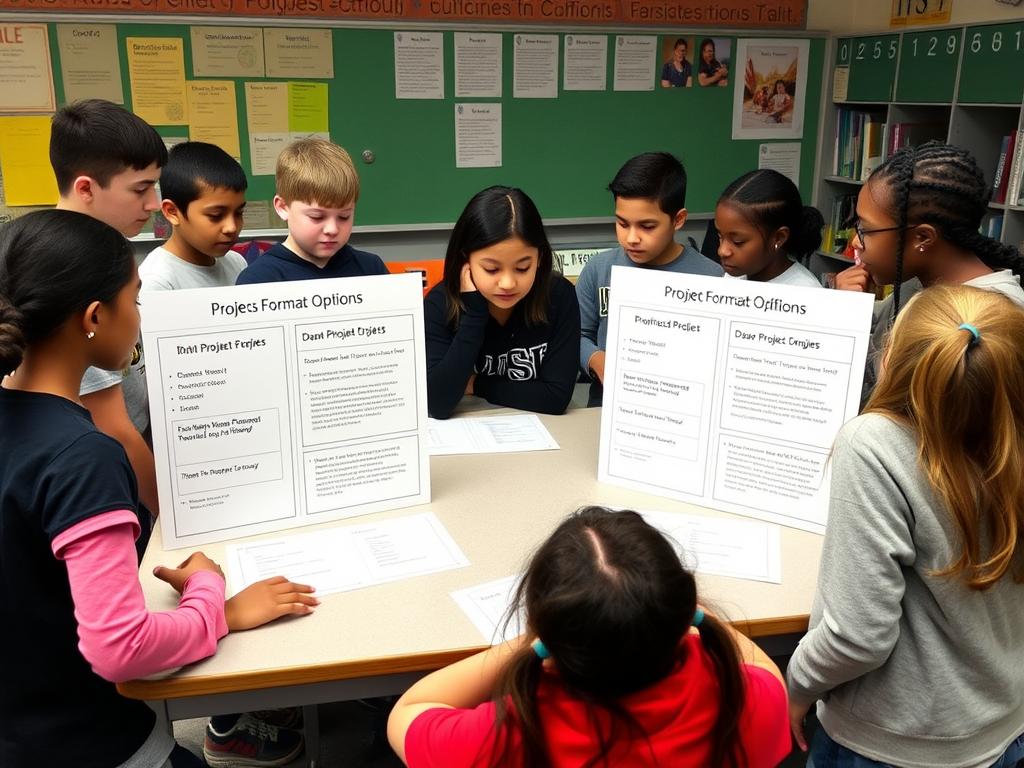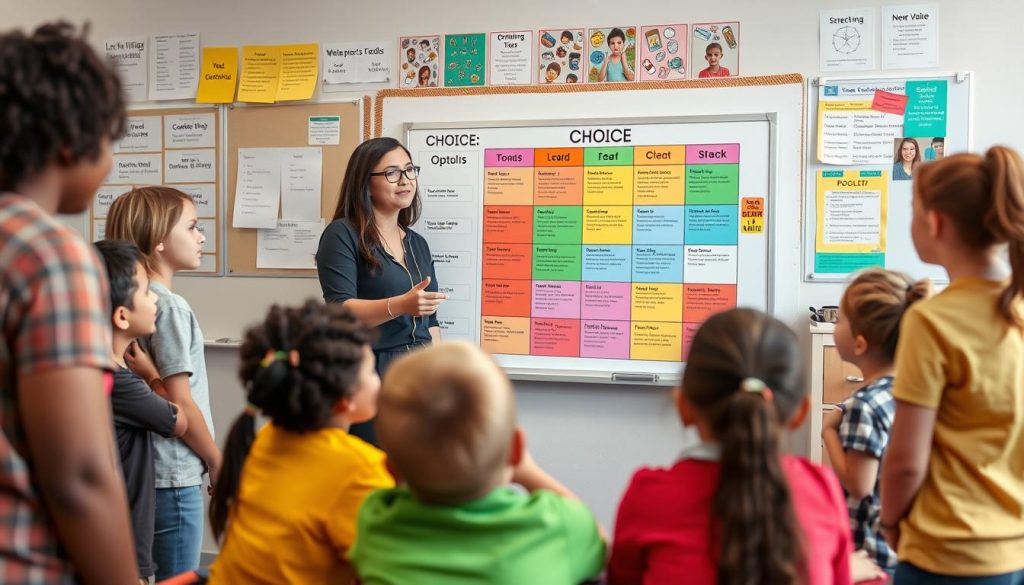Why Student Choice Ideas Matter in Today’s Classroom
Before diving into specific student choice ideas, let’s understand why they’re so valuable. When students have a say in their learning, they develop ownership and intrinsic motivation. Research shows that providing choices improves both behavioral and cognitive engagement. As teachers develop these teacher skills, they create learning environments where students are more invested in their education.
Implementing student choice ideas doesn’t mean abandoning structure or standards. Rather, it means offering controlled options that still meet learning objectives. This approach helps develop critical teacher skills like facilitation and differentiation while giving students the autonomy they crave.
“Teachers gain the cooperation they need when they give away the control they don’t need.”
– Teaching with Love and Logic
The key to successful student choice ideas is offering options that all lead to desired learning outcomes. This strategy develops teacher skills in creating meaningful choices while ensuring educational standards are met. Let’s explore twenty practical ways to implement this approach.
Student Choice Ideas for Elementary Classrooms
Elementary students are developing independence and decision-making abilities. These student choice ideas help younger learners practice making good choices while building essential teacher skills in guiding this age group.

- Learning Center Selection: Allow students to choose which learning center to visit first. This develops teacher skills in creating engaging, multi-option learning environments while giving students agency in their learning sequence.
- Reading Material Options: Provide a selection of books at appropriate reading levels and let students choose what to read during independent reading time. This builds teacher skills in curating appropriate reading materials while fostering student interest in reading.
- Spelling Practice Methods: Offer 2-3 different ways to practice spelling words (rainbow writing, letter stamps, or word searches). This enhances teacher skills in differentiation while accommodating different learning preferences.
- Partner or Solo Work: For appropriate assignments, let students decide whether to work independently or with a partner. This develops teacher skills in managing different work arrangements while teaching students to assess their own learning needs.
- Homework Submission Schedule: Allow students to choose whether to turn in homework throughout the week or all at once on Friday. This builds teacher skills in flexible assessment while teaching students time management.
Want to Master Student Choice in Your Classroom?
Discover proven strategies for implementing student choice while maintaining classroom control. Our comprehensive guide helps you develop essential teacher skills for a more engaged classroom.
Effective Student Choice Ideas for Middle School
Middle school students crave independence but still need guidance. These student choice ideas help teachers develop the teacher skills needed to navigate this delicate balance.

- Assessment Format Options: Let students choose how to demonstrate their knowledge—through a written report, presentation, or creative project. This builds teacher skills in diverse assessment methods while honoring different student strengths.
- Problem Selection: Allow students to choose which 10 math problems to complete from a worksheet of 15. This develops teacher skills in creating comprehensive problem sets while giving students some control.
- Reading Response Methods: Offer choices for responding to reading—journal entries, graphic organizers, or discussion questions. This enhances teacher skills in literacy instruction while accommodating different learning styles.
- Seating Arrangements: When appropriate, let students choose where to sit with the caveat “as long as it doesn’t cause problems.” This builds teacher skills in classroom management while teaching students responsibility.
- Project Topics: Within curriculum requirements, allow students to choose specific topics for research or projects. This develops teacher skills in guiding inquiry while increasing student investment.
Middle school teachers who implement these student choice ideas often report fewer behavior issues and increased engagement. These approaches help develop critical teacher skills in balancing structure with flexibility—a key competency for working with this age group.
When implementing student choice ideas with middle schoolers, clearly communicate the parameters of each choice. This helps students understand their options while developing your teacher skills in setting appropriate boundaries.
Advanced Student Choice Ideas for High School
High school students are preparing for adult independence. These student choice ideas help teachers develop the teacher skills needed to guide older students toward self-direction while maintaining academic rigor.

- Research Methodology: Allow students to choose their research approach—interviews, literature review, or data analysis. This builds teacher skills in guiding diverse research methods while preparing students for college-level work.
- Text Selection: Within curriculum requirements, offer a selection of texts that address the same standards and let students choose. This develops teacher skills in curriculum design while increasing student engagement with reading.
- Assignment Deadlines: For major projects, give students limited flexibility in setting their own deadlines within a defined window. This enhances teacher skills in project management while teaching students time management.
- Discussion Formats: Offer choices between written discussions, verbal debates, or digital forums. This builds teacher skills in facilitating different types of discourse while accommodating student preferences.
- Assessment Weighting: Allow students some choice in how different assignments are weighted in their final grade (within parameters). This develops teacher skills in assessment design while teaching students to evaluate their own strengths.
High school teachers who implement these student choice ideas often find their students are better prepared for the independence of college and careers. These approaches help develop advanced teacher skills in mentoring and facilitating rather than directing.
Implementing Student Choice Ideas: Practical Tips
Successfully implementing student choice ideas requires thoughtful planning and specific teacher skills. Here are five additional ideas along with practical implementation tips.

16. Choice Boards
Create a grid of 9 activities that all address the same learning objective but in different ways. Students choose which activities to complete. This develops teacher skills in differentiated instruction while giving students agency in how they learn.
17. Reflection Methods
Offer students choices in how they reflect on their learning—journals, exit tickets, or audio recordings. This builds teacher skills in metacognitive instruction while honoring different communication preferences.
18. Technology Tools
When appropriate, let students choose which digital tools to use for creating or presenting work. This enhances teacher skills in technology integration while allowing students to work with tools that best fit their needs.
19. Peer Feedback Methods
Allow students to choose how they give and receive peer feedback—written comments, conferences, or structured protocols. This develops teacher skills in facilitating peer learning while teaching students valuable communication skills.
20. Environmental Choices
When possible, let students choose environmental factors like lighting, background music (with headphones), or flexible seating. This builds teacher skills in creating optimal learning environments while acknowledging individual preferences.
Implementation Tip: Start small with one or two student choice ideas rather than transforming everything at once. This allows you to develop the necessary teacher skills gradually while helping students adjust to having more agency in their learning.
Remember that implementing student choice ideas is about finding the right balance between structure and freedom. The goal is to develop teacher skills that allow you to guide without controlling, while helping students learn to make responsible choices about their own learning.
Ready to Transform Your Classroom?
Get our comprehensive guide on implementing student choice effectively. Develop the teacher skills you need to create an engaging, student-centered learning environment.
Overcoming Challenges with Student Choice Ideas
While implementing student choice ideas offers many benefits, teachers often encounter challenges. Developing specific teacher skills can help address these obstacles effectively.
What if students always choose the easiest option?
Design choices that require similar effort but through different approaches. This develops teacher skills in creating equitable options while preventing students from always taking the path of least resistance.
How do I maintain standards while offering choices?
Create a clear rubric that applies to all choice options. This builds teacher skills in assessment design while ensuring all choices lead to the same learning standards.
What if choice leads to classroom management issues?
Establish clear procedures for making and implementing choices. This enhances teacher skills in classroom management while teaching students how to handle freedom responsibly.
Successfully navigating these challenges requires developing specific teacher skills in facilitation, clear communication, and thoughtful design of choice opportunities. With practice, these skills become second nature, making student choice ideas easier to implement effectively.
Conclusion: Balancing Choice and Guidance
Implementing student choice ideas in your classroom doesn’t mean abandoning your role as the educational expert. Instead, it means developing the teacher skills needed to guide students while giving them appropriate agency in their learning journey.
The twenty student choice ideas we’ve explored offer practical ways to share control without losing it. By thoughtfully implementing these strategies, you’ll develop essential teacher skills while creating a more engaging, student-centered learning environment.
Remember that the goal isn’t to implement every idea at once, but to gradually incorporate choices that work for your teaching style, your students, and your curriculum. As you develop these teacher skills, both you and your students will experience the benefits of a more collaborative, empowering approach to education.
Continue Your Professional Development
Enhance your teacher skills with our comprehensive resources on student choice and classroom management. Join thousands of educators who are transforming their classrooms through student agency.




